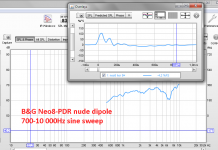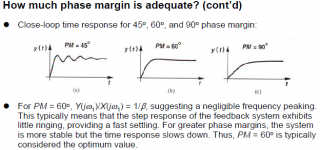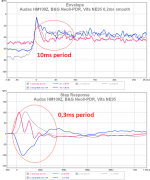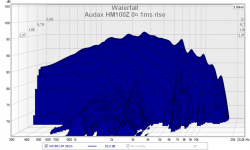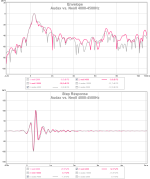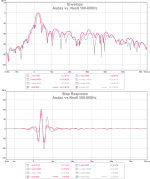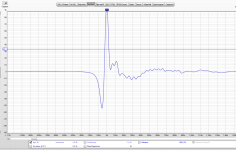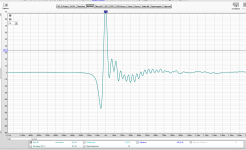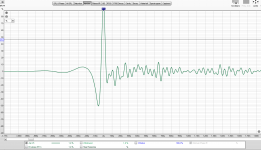I posted these in my AINOgradient thread but so far discussion is minimal,
What is the importance of ringing in impulse/step response of a transducer?
I measured two dynamic coil drivers and planar/ribbon B&G Neo8-PDR in dipole minimal baffle. Responses, distortion and decay are naturally different but not much,
Here are ETC, impulse and step responses (ne-95 different polarity)
ETC is fastest for Neo8, but it has ringing Step response - Wikipedia, the free encyclopedia
The phenomena of oscillation about final value is called ringing. The overshoot is the maximum swing above final value, and clearly increases with μ. Likewise, the undershoot is the minimum swing below final value, again increasing with μ. The settling time is the time for departures from final value to sink below some specified level, say 10% of final value.
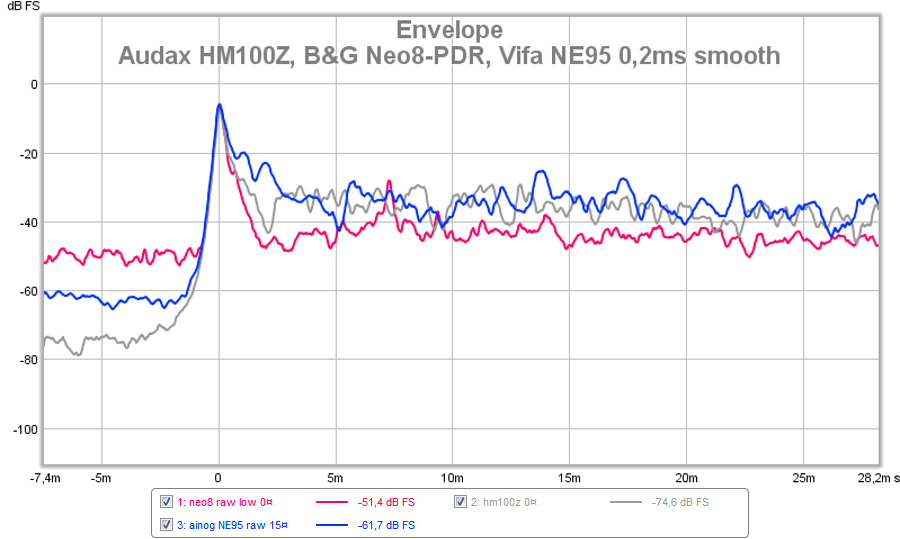
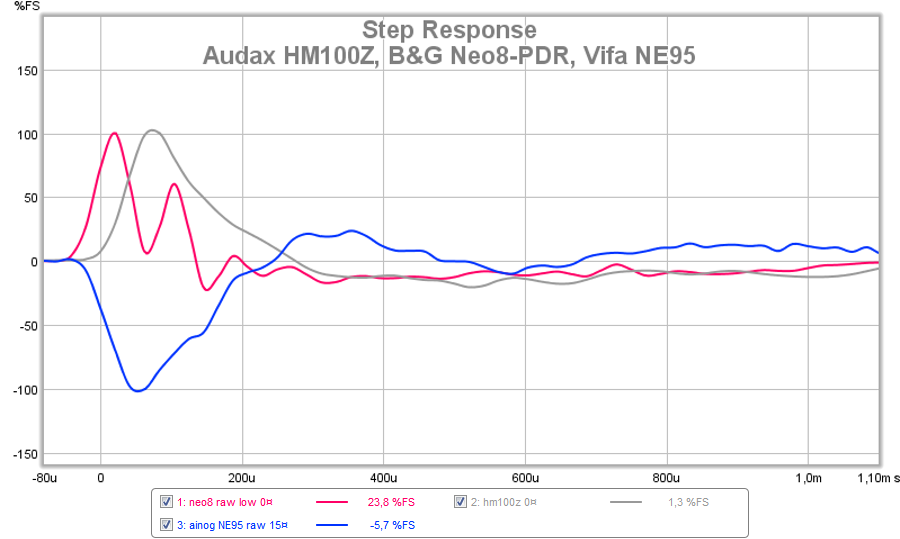
What is the importance of ringing in impulse/step response of a transducer?
I measured two dynamic coil drivers and planar/ribbon B&G Neo8-PDR in dipole minimal baffle. Responses, distortion and decay are naturally different but not much,
Here are ETC, impulse and step responses (ne-95 different polarity)
ETC is fastest for Neo8, but it has ringing Step response - Wikipedia, the free encyclopedia
The phenomena of oscillation about final value is called ringing. The overshoot is the maximum swing above final value, and clearly increases with μ. Likewise, the undershoot is the minimum swing below final value, again increasing with μ. The settling time is the time for departures from final value to sink below some specified level, say 10% of final value.


Last edited:
I wouldn't ascribe too much to the ringing of a step or impulse response.
Remember that an impulse is similar to a white noise source. Half of its energy is in the top Octave so it higlights tweeter ringing that may be at a supersonic frequency. Lots of metal domes ring out of band and have poor looking impulses because of it. Unless you have "bat hearing" it probably won't be audible.
If you have a good eye and practice you can see some details in a multiway steo, such as relative driver polarity and delay. Still, I wouldn't say those matter, just that they might be revealed.
Step response is similar, but integrated, so bass end is a little more visible.
Best thing to do with an impulse is FFT it so that you can see frequency response.
David
Remember that an impulse is similar to a white noise source. Half of its energy is in the top Octave so it higlights tweeter ringing that may be at a supersonic frequency. Lots of metal domes ring out of band and have poor looking impulses because of it. Unless you have "bat hearing" it probably won't be audible.
If you have a good eye and practice you can see some details in a multiway steo, such as relative driver polarity and delay. Still, I wouldn't say those matter, just that they might be revealed.
Step response is similar, but integrated, so bass end is a little more visible.
Best thing to do with an impulse is FFT it so that you can see frequency response.
David
These graphs ar from REW measurements, it does a sine sweep (here 100Hz -20kHz). Single drivers without any xo or eq.
This is amplitude response from those.from a sweep Below is a new attachment from a sweep just 500-10000Hz
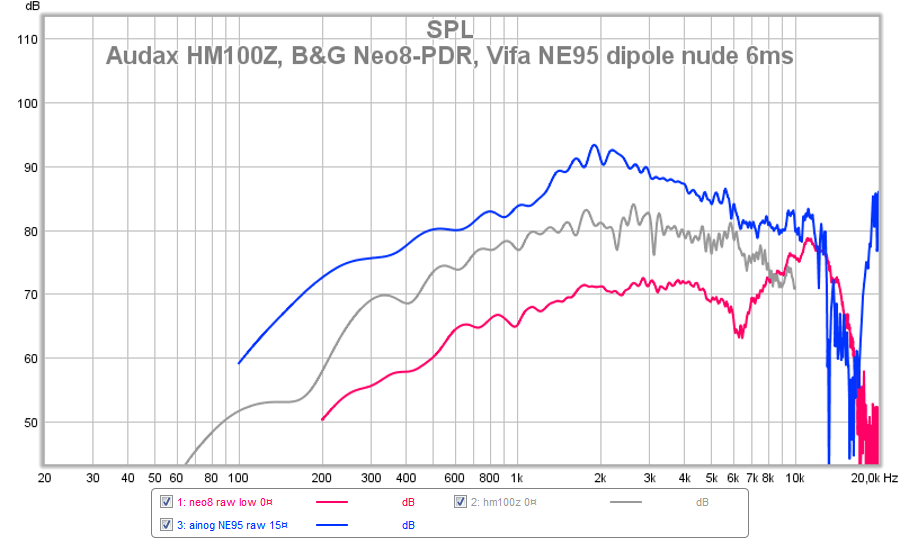
This is amplitude response from those.from a sweep Below is a new attachment from a sweep just 500-10000Hz

Attachments
Last edited:
Impulse responses can be a decent diagnostic tool, but as Dave says, you have to be careful about how you look at them. The HFs will always appear the most obvious. Look for ringing that occurs somewhere out away from the initial decay, such as the ETC peak at 7 ms in the red curve. Except that I suspect that 7 ms peak is from your room. But a peak like that would be an issue for me and I might investigate further if I knew that it was not from the room - say at 2 ms. I often look at the frequency response over a limited range of the impulse response to see if something shows up (say 1-3 ms if there is a peak at 2 ms). Of course doing this makes the resolution very poor, but it can sometimes tell you the frequency range of a potential problem. Then go and look at the frequency response in that frequency range, or better yet the polar response and see if something is apparent.
If, for example, there is an aberration in the polar map then you can use the impulse response timing (2 ms in the example) and the speed of sound to see if you can trace down something, although this doesn't always work since it could be structural and the speed of sound is different.
Never use the impulse response alone as it is only useful in the context of its frequency response.
If, for example, there is an aberration in the polar map then you can use the impulse response timing (2 ms in the example) and the speed of sound to see if you can trace down something, although this doesn't always work since it could be structural and the speed of sound is different.
Never use the impulse response alone as it is only useful in the context of its frequency response.
Last edited:
Ok, if one cannot hear driver's impulse ringing.
If that kind or response would show up in an amplifier, no one would use it!
http://cc.ee.nchu.edu.tw/~aiclab/teaching/AIC/lect10.pdf
If that kind or response would show up in an amplifier, no one would use it!
http://cc.ee.nchu.edu.tw/~aiclab/teaching/AIC/lect10.pdf
Attachments
Last edited:
NO, no one said that. You certainly can hear impulse response ringing, just not what you see on the very early part of the impulse response. That's too high in frequency. You need to look later and with a wider wavelength.
Ringing like you show in an amplifier implies instability. As a passive device a speaker cannot be unstable so that very HF ringing is not the same issue as it is in an amp. But is an amp had a 3 dB peak at 25 kHz it would not be audible, yet would show up as a serious ringing in the impulse response. A peak at 3 dB 100 Hz would be barely visible because of its long period and yet would be quite audible.
Ringing like you show in an amplifier implies instability. As a passive device a speaker cannot be unstable so that very HF ringing is not the same issue as it is in an amp. But is an amp had a 3 dB peak at 25 kHz it would not be audible, yet would show up as a serious ringing in the impulse response. A peak at 3 dB 100 Hz would be barely visible because of its long period and yet would be quite audible.
Ok, so we don't care about what happens during first 0,3ms but focus on what happens during first 5ms period.
In this perspective ribbon Neo8 is superior to Vifa NE95 and Audax HM100. We can see the first room reflection coming at 7ms. The Audax is considered one of all-time fastest 4" cone drivers, and it really is superior to the modern neo-motor Vifa NE.
This impulse/step response graphics is the same thing that we see in CSD graphs, then we have also frequency icluded.
In this perspective ribbon Neo8 is superior to Vifa NE95 and Audax HM100. We can see the first room reflection coming at 7ms. The Audax is considered one of all-time fastest 4" cone drivers, and it really is superior to the modern neo-motor Vifa NE.
This impulse/step response graphics is the same thing that we see in CSD graphs, then we have also frequency icluded.
Attachments
Last edited:
Ok, so we don't care about what happens during first 0,3ms but focus on what happens during first 5ms period.
I wouldn't say that, more that each time span relates to a particular frequency range.
Your red curve is quite distinctive with some clear ringing. It looks to me like there are 5 cycles in 400 usec. Thats 5 cycles in 0.4 msec or 12.5 cycles in 1 msec.... 12.5 kHz. In the frequency response curve there is a strong peak at that frequency so we know that the peak and the ringing are one and the same.
At the same time the response dip at 7kHz should be clearly audible but I'm not seeing it in the time response. I'm sure it is there somewhere but it isn't obvious.
If we look at the blue frequency response there is a pretty strong prominance at 2kHz. That would correspond with a period of 500 uSec. I do see an inflection a 600 uSec that might correspond with it. Hard to say if that is truly periodic without seeing a longer trace.
I think that is the point. Some strong aberrations in the upper frequency range can be picked out of a step or impulse response, but the frequency response is much easier for us to get meaning from.
David
This is kind of funny - I slipped and fell on my b*tt this morning when getting the papers from the mailbox, so I can't go out and enjoy the nice weather today...
I made some new measurements of Neo8 and Audax. Raw drivers handheld at 10cm from microphone. REW sweeps of limited frequency.
ETC and Step response 500-600Hz, 4000-4500Hz and 10000-10500Hz
I am planning to use Neo8 with LR4 xo at 800Hz and 4500Hz, the most comfortable dipole range it has.
I made some new measurements of Neo8 and Audax. Raw drivers handheld at 10cm from microphone. REW sweeps of limited frequency.
ETC and Step response 500-600Hz, 4000-4500Hz and 10000-10500Hz
I am planning to use Neo8 with LR4 xo at 800Hz and 4500Hz, the most comfortable dipole range it has.
Attachments
We are examining just driver performance, not a speaker. So far I haven't noticed any kind of difference in impulse response when a diriver is free and handheld or attached to a baffle (dipole).
Electromagnetic planar drivers are said to be fast with transients and perfect square wave etc, to have fast impulse rise time, fast decay etc. The reason for this is minimal Mms (practically zero because the membrane just vibrates.)
There is more discussion of planars in that section of diyaudio forums, but I could not find this kind of topic. And I am comparing a planar to a cone driver.
This is how B&G Radia rants of Neo planars http://www.parts-express.com/pedocs...r-graebener-neo8-pdr-specifications-44311.pdf
A complete (multiway) speaker is a different story, not the subject of this thread.
Electromagnetic planar drivers are said to be fast with transients and perfect square wave etc, to have fast impulse rise time, fast decay etc. The reason for this is minimal Mms (practically zero because the membrane just vibrates.)
There is more discussion of planars in that section of diyaudio forums, but I could not find this kind of topic. And I am comparing a planar to a cone driver.
This is how B&G Radia rants of Neo planars http://www.parts-express.com/pedocs...r-graebener-neo8-pdr-specifications-44311.pdf
"The NEO8/ NEO8PDR have a push-pull symmetrical magnet system that has been designed with the help of Finite Element Analysis software to achieve optimum efficiency/cost performance. It uses the newest grades of neodymium – the “super” magnet material with the highest magnetic energy. The extremely light Kaladex diaphragm with an etched planar aluminum conductor is suspended in a magnetic field and is uniformly driven by the electromagnetic force providing accurate and immediate reproduction of the input signal. NEO8/NEO8PDR do not have heavy voice coils, spiders, glue joints, paper cones and surrounds, there is virtually nothing between the electrical signal and the sound - just an almost weightless diaphragm. Hence these planar transducers do not have cone break-up resonance with associated distortion, phase incoherency or signal smear ing that is common for conventional drivers. This allows Neo drivers delivering clean, airy, transparent sound that is inherently natural and musically pleasing."
A complete (multiway) speaker is a different story, not the subject of this thread.
Last edited:
Push pull planars were developed by Bruce Thigpin of Eminent Technology, Inc. Planar Magnetic Loudspeakers and Audio Technology
The Monsoon planars I have are based on the same tech, albiet licensed. Not sure if his patent ran out? 😕
The Monsoon planars I have are based on the same tech, albiet licensed. Not sure if his patent ran out? 😕
To whom it may concern:
The ringing can indeed be an indicator of harsh sound.
I have quite a collection of JBL 050Ti tweeters. Some sound great some sound harsh. So I wanted to find out why that is. And the main difference between great and harsh is the ringing that one can see in the impulse response. The reason for the ringing can be:
- degenerated foam beneath the dome (very obvious)
- slightly pushed out diaphragm caused by abuse. This one took me quite a while to realise as it is visually almost not recognisable.
- dented diaphragm
I attached some screenshots, where one can see the 17kHz ringing (good, bad, very bad tweeter). The foam can be replaced with some open celled, soft foam of appropriate size (15 mm Diameter, 25,4 mm long). The pushed out diapgram I was not able to repair. Tried to suck it in with a vacuum until the dome collapsed 😀
Cheerio 😉
The ringing can indeed be an indicator of harsh sound.
I have quite a collection of JBL 050Ti tweeters. Some sound great some sound harsh. So I wanted to find out why that is. And the main difference between great and harsh is the ringing that one can see in the impulse response. The reason for the ringing can be:
- degenerated foam beneath the dome (very obvious)
- slightly pushed out diaphragm caused by abuse. This one took me quite a while to realise as it is visually almost not recognisable.
- dented diaphragm
I attached some screenshots, where one can see the 17kHz ringing (good, bad, very bad tweeter). The foam can be replaced with some open celled, soft foam of appropriate size (15 mm Diameter, 25,4 mm long). The pushed out diapgram I was not able to repair. Tried to suck it in with a vacuum until the dome collapsed 😀
Cheerio 😉
Attachments
Last edited:
Usually audible ringing begins from 10+ mS. Short post ringing is hardly noticeable.
http://www.bodziosoftware.com.au/Pre_Post_Ringing_IR_And_Pulses.pdf
http://www.bodziosoftware.com.au/Pre_Post_Ringing_IR_And_Pulses.pdf
- Home
- Loudspeakers
- Multi-Way
- Step response ringing
